I'm currently working on a POC project and I'm trying to figure out how I can share a service dependency between different endpoints to control application state and handle all service requests (lets call it ControlService) - specifically when one of those endpoints is a KestrelCommunicationListener / HttpSysCommunicationListener and combined with a FabricTransportServiceRemotingListener (or any other type of custom listener)
Autofac looked promising but the examples don't show how to get a HTTP listener working when the container is built in startup rather than the main entry point - would I need to pass the container to MyFabricService so it can be passed into and added to by the startup registrations?
I've seen references to using container.Update() or adding registrations on the fly using container.BeginLifetimeScope() but they are all using a container built in main and then I'm not sure how I would add the APIs created by the HTTP listener to the original container.
I'm possibly not explaining it that well so in summary I'm looking to have something like the below service that can receive communications via n. different endpoints - process the message and then send messages out via n. clients (aka other service endpoints)
Happy to clarify if anything is unclear - perhaps even using another creative diagram :)
Updated:
From Program.Main()
ServiceRuntime.RegisterServiceAsync("ManagementServiceType",
context => new ManagementService(context)).GetAwaiter().GetResult();
Here is my fabric service
public ManagementService(StatefulServiceContext context)
: base(context)
{
//this does not work but is pretty much what I'm after
_managementService = ServiceProviderFactory.ServiceProvider.GetService(typeof(IManagementService)) as IManagementService;
}
protected override IEnumerable<ServiceReplicaListener> CreateServiceReplicaListeners() =>
new ServiceReplicaListener[]
{
//create external http listener
ServiceReplicaListenerFactory.CreateExternalListener(typeof(Startup), StateManager, (serviceContext, message) => ServiceEventSource.Current.ServiceMessage(serviceContext, message), "ServiceEndpoint"),
//create remoting listener with injected dependency
ServiceReplicaListenerFactory.CreateServiceReplicaListenerFor(() => new RemotingListenerService(_managementService), "ManagmentServiceRemotingEndpoint", "ManagementServiceListener")
};
ServiceReplicaListener
public static ServiceReplicaListener CreateExternalListener(Type startupType, IReliableStateManager stateManager, Action<StatefulServiceContext, string> loggingCallback, string endpointname)
{
return new ServiceReplicaListener(serviceContext =>
{
return new KestrelCommunicationListener(serviceContext, endpointname, (url, listener) =>
{
loggingCallback(serviceContext, $"Starting Kestrel on {url}");
return new WebHostBuilder().UseKestrel()
.ConfigureServices((hostingContext, services) =>
{
services.AddSingleton(serviceContext);
services.AddSingleton(stateManager);
services.AddApplicationInsightsTelemetry(hostingContext.Configuration);
services.AddSingleton<ITelemetryInitializer>((serviceProvider) => new FabricTelemetryInitializer(serviceContext));
})
.ConfigureAppConfiguration((hostingContext, config) =>
{
config.AddServiceFabricConfiguration(serviceContext);
})
.ConfigureLogging((hostingContext, logging) =>
{
logging.AddConfiguration(hostingContext.Configuration.GetSection("Logging"));
logging.AddDebug();
})
.UseContentRoot(Directory.GetCurrentDirectory())
.UseServiceFabricIntegration(listener, ServiceFabricIntegrationOptions.None)
.UseStartup(startupType)
.UseUrls(url)
.Build();
});
});
}
Startup
public class Startup
{
private const string apiTitle = "Management Service API";
private const string apiVersion = "v1";
private readonly IConfiguration configuration;
public Startup(IConfiguration configuration)
{
this.configuration = configuration;
}
public void ConfigureServices(IServiceCollection services)
{
var modules = new List<ICompositionModule>
{
new Composition.CompositionModule(),
new BusinessCompositionModule()
};
foreach (var module in modules)
{
module.AddServices(services, configuration);
}
services.AddSwashbuckle(configuration, apiTitle, apiVersion, "ManagementService.xml");
}
public void Configure(IApplicationBuilder app, IHostingEnvironment env, ILoggerFactory loggerFactory)
{
loggerFactory.AddApplicationInsights(app.ApplicationServices);
// app.UseAuthentication();
// app.UseSecurityContext();
if (env.IsDevelopment())
{
app.UseDeveloperExceptionPage();
// app.UseBrowserLink();
}
else
{
app.UseExceptionHandler("/Home/Error");
}
app.UseStaticFiles();
app.UseCors("CorsPolicy");
app.UseMvc();
app.UseSwagger(apiTitle, apiVersion);
//app.UseMvc(routes =>
//{
// routes.MapRoute(
// name: "default",
// template: "{controller=Home}/{action=Index}/{id?}");
//});
}
}
All the service dependencies are added in the CompositionModules using Microsoft.Extensions.DependencyInjection (not autofac) in startup.cs
This works great and creates my HTTP listener - I now just need a way of getting access to my services that were added to the container during startup of my http listener / webhost.

